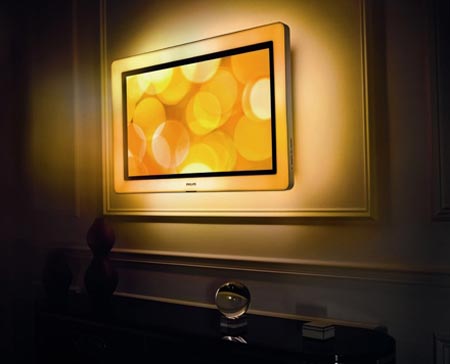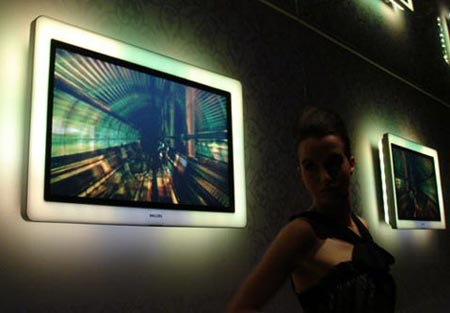Just a year after the first outing, Philips has updated its Aurea TV offering with a new model aptly named the Aurea 2.
For those unaware, the premise of the Aurea TV is that rather than just shine light out the back of the TV using the company’s Ambilight technology, light shines from the frame itself towards you. The technology, according to Philips, will reduce the strain on your eyes, make the picture look better and be a pleasant experience all round (geddit?).
So what’s new? Following on from the first generation set, Philips has refined the television design and frame. Now instead of a big hunk of plastic surrounding the television, the “light frame” is made from a single sheet of glass. This as you can imagine gives a much better finish and something that will be, most likely, more in keeping with your décor.
The frame also takes on the new Philips television styling that means it’s further surrounded (framed) in a clear plastic shell. It’s a nice design aesthetic that also doubles up to pump the sound in your general direction – an invisible speaker so to speak.
Coming in a 42-inch screen size the glass frame makes the overall television akin to a 47-inch model and it’s something to bear in mind when you measure the space it’s going to go in.
Designed to be wall mounted (a stand does come in the box) the Aurea is unlike other televisions in that you really should wall mount it to benefit from the light bouncing off the wall. That’s not to say you can’t shove it in a corner covered in flock wallpaper, but you just won’t get a decent effect. In fact if you are hoping to get the most out of the television’s Ambilight technology you need to not only mount it on the wall, but make sure that wall is white.
So now you’ve redecorated your lounge to fit around your television what about the picture quality? The Aurea uses the new 2008 Philips 9000 series panel that first started appearing in televisions from Philips from around February. The results we saw then and now have carried through to this model and are very impressive with motion blurring and jaggedness kept to a minimum and blacks well reproduced.
The television sports the latest version of Philips Perfect Pixel HD engine and this means the television is doing plenty to clean up the image regardless of the source.
Obviously the better the source the better the picture but on the range of DVD, Blu-ray, HD DVD, Sky HD and standard definition content we tested the Aurea on, the technology worked well to enhance and improve the image quality.
Annoyingly the over-compensation technology we noticed on the first version of the Aurea is still here and you can get halo effects around people’s heads as presumably the technologies try and do the best to clean the image. This, though, is infrequent and something that you’ll notice now and then if you look out for it rather than something that hinders every frame. Better still this can be turned down to avoid it happening.
On the resolution front you get 1080p giving you the magic “Full HD” buzzword and the screen operates at 100Hz with a 2ms response time (down from 3ms last time around) for an enhanced viewing experience, removing blurry images in real time. The contrast ratio is 30,000:1.
Those looking to connect their HD world to the set will be pleased to see the set includes four HDMI (up from three) sockets. Three can be found at the back of the unit with one on the side so you can connect a camcorder or other device without having to fiddle blind around the back.
The Aurea is now also DLNA compatible meaning you can browse PC and home network content from other DLNA devices like the Samsung i8510.








